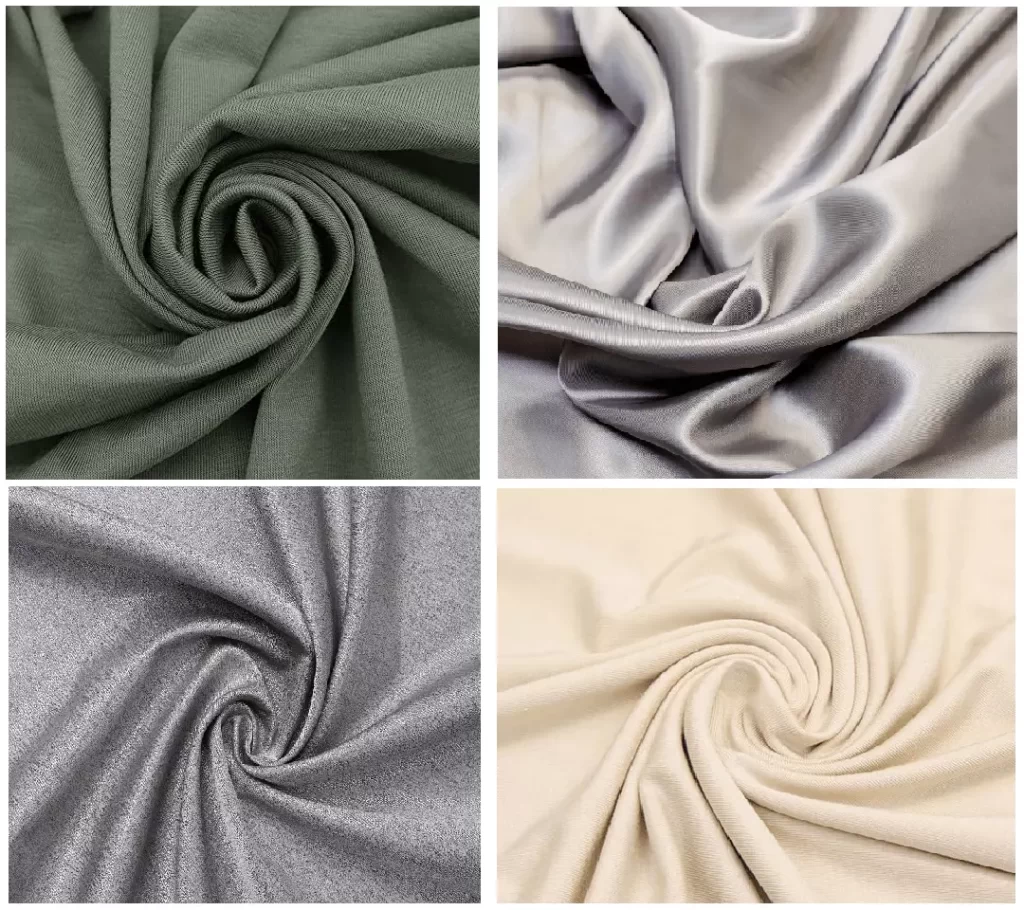Understanding Modal Fabric: A Comprehensive Guide
Modal fabric is a type of semi-synthetic fiber that has gained popularity in the textile industry for its softness, durability, and versatility. Derived from beech tree pulp, modal is often used in clothing, home textiles, and various other applications. This article will explore the characteristics, benefits, production process, and uses of modal fabric, as well as address common questions about this material.
What is Modal Fabric?
Modal is a type of rayon, which is a regenerated cellulose fiber. It is produced from the pulp of beech trees through a chemical process that transforms the wood into fibers suitable for textile production. Modal fabric is known for its luxurious feel, similar to silk, and is often used as an alternative to cotton, polyester, and other fabrics.
Characteristics of Modal Fabric
- Softness: Modal is exceptionally soft and smooth, making it comfortable to wear against the skin.
- Breathability: Modal fabric is breathable, allowing air to circulate, which helps regulate body temperature.
- Moisture-Wicking: Modal has excellent moisture-wicking properties, meaning it can absorb and release moisture effectively, keeping the wearer dry.
- Durability: Modal is strong and resistant to wear and tear, making it suitable for everyday use.
- Color Retention: Modal fabric holds dye well, resulting in vibrant colors that do not fade easily.
- Biodegradable: Since modal is derived from natural sources, it is biodegradable, making it a more environmentally friendly option compared to synthetic fibers.
The Production Process of Modal Fabric
The production of modal fabric involves several steps, starting from the harvesting of beech trees to the final textile product. Here is a simplified overview of the modal production process:
Step 1: Harvesting
Beech trees are harvested for their wood pulp, which is the primary raw material for modal production. Sustainable forestry practices are often employed to ensure that the harvesting process does not harm the environment.
Step 2: Pulping
The harvested wood is processed to extract cellulose fibers. This involves breaking down the wood into its chemical components, primarily cellulose, through a chemical pulping process.
Step 3: Regeneration
The cellulose is then dissolved in a solvent to create a viscous solution. This solution is extruded through spinnerets, which are small holes that form the fibers as the solution solidifies upon contact with air.
Step 4: Spinning
The newly formed fibers are spun into yarn, which can be woven or knitted into fabric. The spinning process can vary depending on the desired texture and characteristics of the final product.
Step 5: Finishing
The modal fabric undergoes various finishing processes, such as bleaching, dyeing, and softening, to enhance its appearance and feel. These processes can also improve the fabric’s performance characteristics.
Step 6: Quality Control
Before being shipped to manufacturers, the modal fabric is subjected to quality control tests to ensure it meets industry standards for softness, durability, and color retention.
Uses of Modal Fabric
Modal fabric is versatile and can be used in a wide range of applications, including:
1. Clothing
Modal is commonly used in the production of clothing items such as:
- T-shirts: Soft and breathable modal t-shirts are popular for everyday wear.
- Dresses: The luxurious feel of modal makes it a great choice for dresses that drape beautifully.
- Loungewear: Modal is often used in pajamas and loungewear due to its comfort and softness.
- Underwear: The moisture-wicking properties of modal make it suitable for underwear.
2. Home Textiles
Modal fabric is also used in home textiles, including:
- Bed Linens: Modal sheets and pillowcases are soft and breathable, providing a comfortable sleeping experience.
- Towels: Modal towels are absorbent and quick-drying, making them ideal for bath and beach use.
- Curtains: Modal can be used for lightweight curtains that allow natural light to filter through while providing privacy.
3. Activewear
Due to its moisture-wicking and breathable properties, modal is increasingly being used in activewear, such as workout tops and leggings.
Benefits of Modal Fabric
Modal fabric offers several benefits that make it a popular choice among consumers and manufacturers:
1. Comfort
The softness and smooth texture of modal make it comfortable to wear, even for extended periods. This is especially important for clothing items that are worn close to the skin.
2. Durability
Modal is known for its strength and durability, making it less likely to pill or wear out compared to other fabrics. This longevity can lead to cost savings for consumers.
3. Eco-Friendly
Modal is derived from renewable resources and is biodegradable, making it a more environmentally friendly option compared to synthetic fibers. Additionally, many manufacturers use sustainable practices in the production of modal.
4. Versatility
Modal can be blended with other fibers, such as cotton or spandex, to enhance its properties and expand its range of uses. This versatility allows for a wide variety of clothing and textile options.
5. Easy Care
Modal fabric is generally easy to care for, as it is machine washable and resistant to shrinking and fading. This makes it a practical choice for everyday wear.
Comparison of Modal Fabric with Other Fabrics
To understand the unique qualities of modal fabric, it is helpful to compare it with other commonly used fabrics:
| Fabric Type | Softness | Breathability | Durability | Moisture-Wicking | Eco-Friendliness |
|---|---|---|---|---|---|
| Modal | High | High | High | High | High |
| Cotton | Moderate | Moderate | Moderate | Low | Moderate |
| Polyester | Low | Low | High | Moderate | Low |
| Rayon | High | Moderate | Low | Moderate | Moderate |
| Silk | Very High | Moderate | Low | Low | Moderate |
Common Misconceptions About Modal Fabric
1. Modal is the Same as Rayon
While modal is a type of rayon, not all rayon is modal. Modal is produced using a specific process that results in a finer, softer fiber compared to standard rayon.
2. Modal is Not Eco-Friendly
Some consumers may believe that modal is harmful to the environment. However, when produced sustainably, modal can be an eco-friendly option due to its biodegradable nature and renewable sources.
3. Modal is Difficult to Care For
Modal is generally easy to care for, as it is machine washable and resistant to shrinking and fading. Proper care instructions should be followed to maintain its quality.
How to Care for Modal Fabric
To ensure the longevity of modal fabric items, follow these care tips:
- Washing: Machine wash modal items in cold water on a gentle cycle. Avoid using bleach, as it can damage the fibers.
- Drying: Air drying is recommended to prevent shrinkage. If using a dryer, select a low heat setting.
- Ironing: If necessary, iron modal items on a low heat setting. Use a pressing cloth to protect the fabric.
- Storage: Store modal clothing in a cool, dry place. Avoid hanging items that may stretch out of shape.
Conclusion
Modal fabric is a versatile and comfortable material that offers numerous benefits for clothing and home textiles. Its softness, breathability, and eco-friendliness make it a popular choice among consumers. Understanding the characteristics, production process, and care requirements of modal fabric can help individuals make informed decisions when purchasing textiles.
FAQ Section
What is modal fabric made from?
Modal fabric is made from the pulp of beech trees, which is processed into cellulose fibers.
Is modal fabric eco-friendly?
Yes, modal fabric is considered eco-friendly when produced sustainably, as it is biodegradable and derived from renewable resources.
How does modal compare to cotton?
Modal is softer and more breathable than cotton, but cotton is generally more durable. Modal also has better moisture-wicking properties.
Can modal fabric be machine washed?
Yes, modal fabric can be machine washed in cold water on a gentle cycle. It is recommended to air dry or use a low heat setting in the dryer.
Is modal fabric suitable for sensitive skin?
Yes, modal fabric is soft and smooth, making it suitable for individuals with sensitive skin.
Where can I find more information about modal fabric?
For more detailed information, you can visit the Wikipedia page on Modal.
How do I know if a fabric is modal?
Look for labels that specify “modal” or “modal blend.” Modal fabric typically has a soft, smooth texture and drapes well.
Are modal fabrics durable?
Modal is known for its durability, but it is important to follow care instructions to maintain its quality over time.
Can modal fabric be blended with other materials?
Yes, modal can be blended with other fibers, such as cotton or spandex, to enhance its properties and expand its range of uses.
What types of clothing are commonly made from modal fabric?
Modal fabric is commonly used in t-shirts, dresses, loungewear, bed linens, and towels.By understanding modal fabric’s characteristics, benefits, and care requirements, consumers can make informed choices when selecting textiles for their wardrobes and homes. The versatility and comfort of modal make it a valuable addition to any fabric collection.



